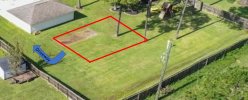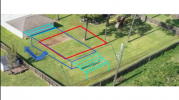- Joined
- Nov 15, 2005
- Messages
- 1,218
So I recently moved again... This time to a property that I foresee my family and I staying on long term. We have space on the back end of the lot to build a shop. I'm looking for some recommendations from all the knowledgeable members of blade forms! Anything is game but to get us kicked off I'll throw out some general questions and wants.
I'm thinking 30'x45' would be around the size I'd want, however, this is flexible. I'm imagining building a shop is like buying a gun safe... always go bigger than what you think you need. One thing I'm not sure about is the height of the ceilings. If I ever did sell the property; tall doors may help people with boats and RVs. But I feel like a ceiling much over 12' could actually be a negative? I was thinking of shooting for 9-10 foot garage doors.
I'd like the option to forge inside, so I'd want to build a ventilation hood for my forge and section off my forging equipment. Maybe have a spot for future power hammer? In this section of the shop, I think I'll also have a garage door opening up to a concrete slab.. for airflow and the potential to take some projects outside.
A grinding room will be a must... I'm not sure on the size, but enough for multiple 2x72s, disk grinder, vise and angle grinder station, etc. Based on Stacy E. Apelt - Bladesmith
's recommendations I think this room will be lined with fire resistant hardi board. Lots of LEDs in this room as well.
Stacy E. Apelt - Bladesmith
's recommendations I think this room will be lined with fire resistant hardi board. Lots of LEDs in this room as well.
Maybe a clean room for assembly and leather work? With a split system in it...
Sink and toilet cabinet?
I'm very early in the process over here and will be getting an architect out to the lot next week to start on drawings. The HOA and city have both verbally signed off on the project conceptually, so that's good.
I'm open to any ideas yall have!
Cheers,
PS... the picture is super rough... but that's what I'm working with and thinking.
I'm thinking 30'x45' would be around the size I'd want, however, this is flexible. I'm imagining building a shop is like buying a gun safe... always go bigger than what you think you need. One thing I'm not sure about is the height of the ceilings. If I ever did sell the property; tall doors may help people with boats and RVs. But I feel like a ceiling much over 12' could actually be a negative? I was thinking of shooting for 9-10 foot garage doors.
I'd like the option to forge inside, so I'd want to build a ventilation hood for my forge and section off my forging equipment. Maybe have a spot for future power hammer? In this section of the shop, I think I'll also have a garage door opening up to a concrete slab.. for airflow and the potential to take some projects outside.
A grinding room will be a must... I'm not sure on the size, but enough for multiple 2x72s, disk grinder, vise and angle grinder station, etc. Based on
Maybe a clean room for assembly and leather work? With a split system in it...
Sink and toilet cabinet?
I'm very early in the process over here and will be getting an architect out to the lot next week to start on drawings. The HOA and city have both verbally signed off on the project conceptually, so that's good.
I'm open to any ideas yall have!
Cheers,
PS... the picture is super rough... but that's what I'm working with and thinking.





